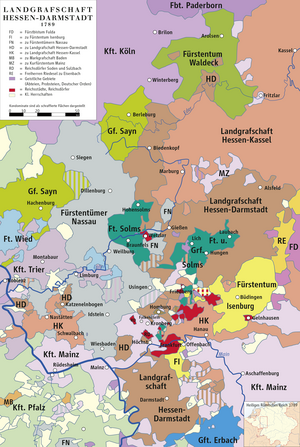헤센다름슈타트 방백국
이 문서는 위키백과의 편집 지침에 맞춰 다듬어야 합니다. (2023년 11월 11일) |
헤센다름슈타트 방백국(독일어: Landgrafschaft Hessen-Darmstadt)은 신성 로마 제국의 국가였으며, 헤센가의 젊은 분파에 의해 통치되었다. 이는 방백 필리프 1세의 네 아들 사이에 헤센 방백국이 분할된 후 1567년에 형성되었다.
| 헤센다름슈타트 방백국 | ||||
|---|---|---|---|---|
| Landgrafschaft Hessen-Darmstadt | ||||
| ||||
 1789년 헤센다름슈타트(HD)와 헤센카셀(HK) | ||||
| 수도 | 다름슈타트 | |||
| 정치 | ||||
| 정치체제 | 군주제 | |||
| 방백 • 1567~1596 • 1596~1626 • 1626~1661 • 1661~1678 • 1678 • 1678~1739 • 1739~1768 • 1768~1790 • 1790~1806 | ||||
| 역사 | ||||
| 역사적 시대 | 나폴레옹 전쟁 | |||
| 역사 | ||||
| • 설립 | 1567년 | |||
| • 해체 | 1806년 | |||
| 인문 | ||||
| 공용어 | 헤센어 | |||
| 종교 | ||||
| 종교 | 루터교 | |||
방백의 거주지는 다름슈타트에 있었기 때문에 이름이 붙여졌다. 나폴레옹 전쟁의 결과로, 1806년 제국이 해체되면서 백국은 헤센 대공국으로 승격되었다.
지리 편집
이 지역은 다름슈타트의 거주지와 북부 헤센주를 포함하는 남부 슈타켄부르크 지역으로 구성되어 있었고 알스펠트, 기센, 그륀베르크, 힌털란드 북서부 글라덴바흐, 비덴코프, 바텐베르크 주변의 사유지와 로어헤센에 있는 볼의 거주지가 있었다.
역사 편집
이 문단에는 한국어로 번역되지 않은 내용이 담겨 있습니다. (2023년 11월 11일) |
The Landgraviate of Hesse-Darmstadt came into existence in 1567, when George, youngest of the four sons of Landgrave Philip I "the Magnanimous", received the Hessian lands in the former upper County of Katzenelnbogen. His eldest brother William IV received the Landgraviate of Hesse-Kassel, while the second son Louis IV obtained Hesse-Marburg, and the third Philipp II became Landgrave of Hesse-Rheinfels.
헤센 전쟁 편집
The Hesse-Rheinfels line became extinct on Philip's death in 1583. When, in 1604, the childless Landgrave Louis IV of Hesse-Marburg died at Marburg Castle, a succession dispute to his lands, along with the sectarian differences between Calvinist Hesse-Kassel and Lutheran Hesse-Darmstadt, led to a bitter, decades-long rivalry. Because the University of Marburg had become Calvinist under the rule of Landgrave Maurice of Hesse-Kassel, his cousin Louis V of Hesse-Darmstadt founded the Lutheran University of Giessen in 1607.
The inheritance conflict was continued in the broader contest of the Thirty Years' War, in which Hesse-Kassel sided with the Protestant estates and Hesse-Darmstadt sided with the Habsburg emperor. The Hesse-Homburg and Hesse-Rotenburg estates seceded from the opponents in 1622 and 1627. Though Hesse-Darmstadt and Hesse-Kassel reached an agreement in 1627, the quarrels rekindled, resulting inter alia in the Siege of Dorsten and culminating in a series of open battles from 1645, when the Kassel Landgravine Amalie Elisabeth besieged Marburg. The conflict was finally settled on the eve of the 1648 Peace of Westphalia, more than eighty years after the division of the estates. Large parts of the disputed Upper Hesse territory including Marburg fell to the elder Kassel line, while Hesse-Darmstadt retained Giessen and Biedenkopf.
18세기~19세기 편집
In 1736, the Landgraves of Hesse-Darmstadt inherited the estates of the extinct Counts of Hanau-Lichtenberg, again contested by their Kassel cousins. Hesse-Darmstadt gained a great deal of territory by the secularizations and mediatizations authorized by the Reichsdeputationshauptschluss of 1803. Most notable was the acquisition of the Duchy of Westphalia, formerly owned by the Prince-Archbishop of Cologne, as well as territories from the Prince-Archbishop of Mainz and the Prince-Bishop of Worms.
In 1806, upon the dissolution of the Holy Roman Empire and the dispossession of his cousin, Elector William I of Hesse-Kassel, Landgrave Louis X joined the Napoleonic Confederation of the Rhine and took the title of Grand Duke of Hesse.
갤러리 편집
-
7년 전쟁 당시 사용된 군 연대의 깃발 (국기는 존재하지 않거나 누락된 것도 있다.)
-
문장 (1736년 ~ 1804년)

